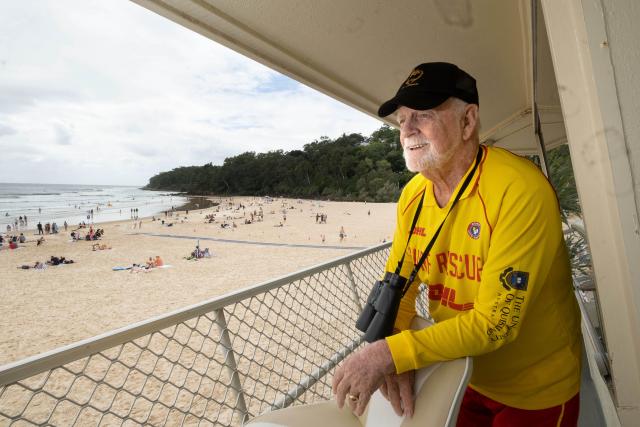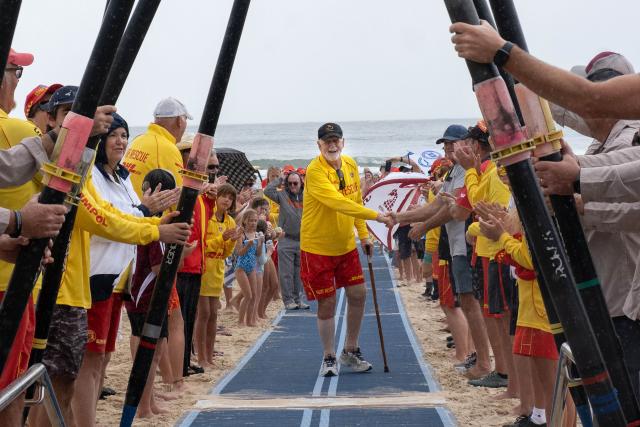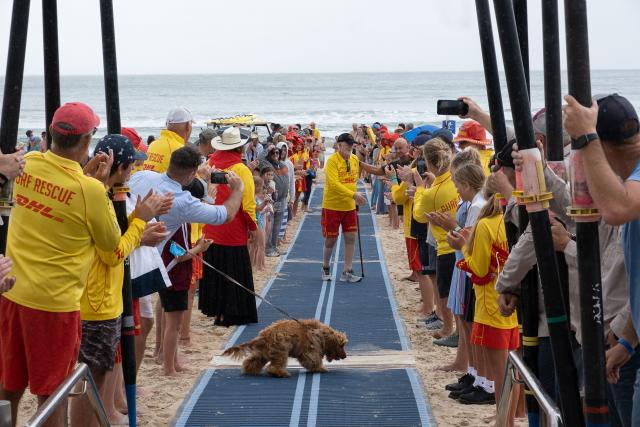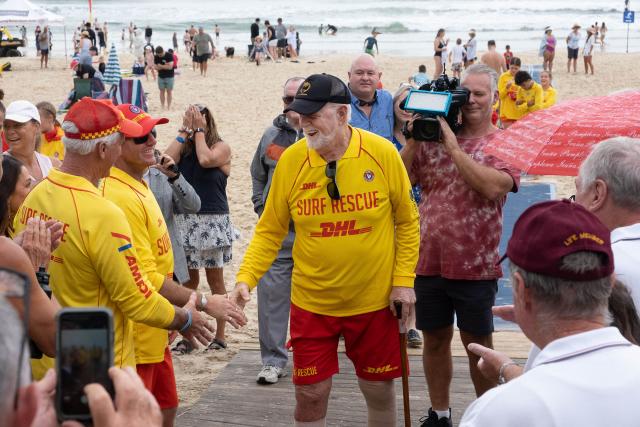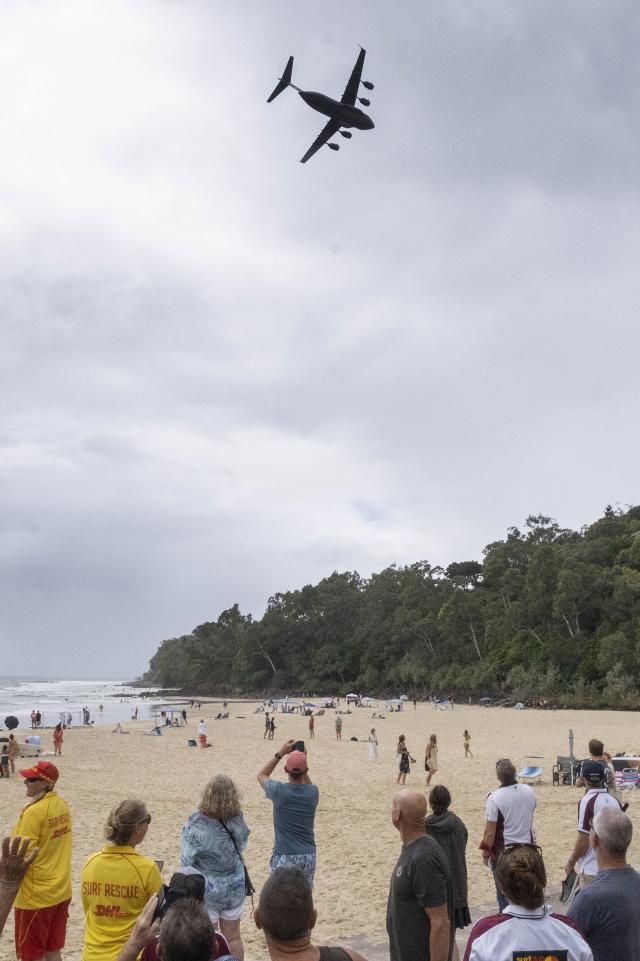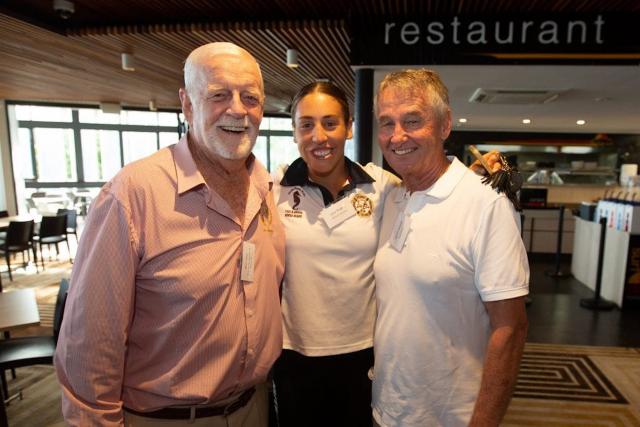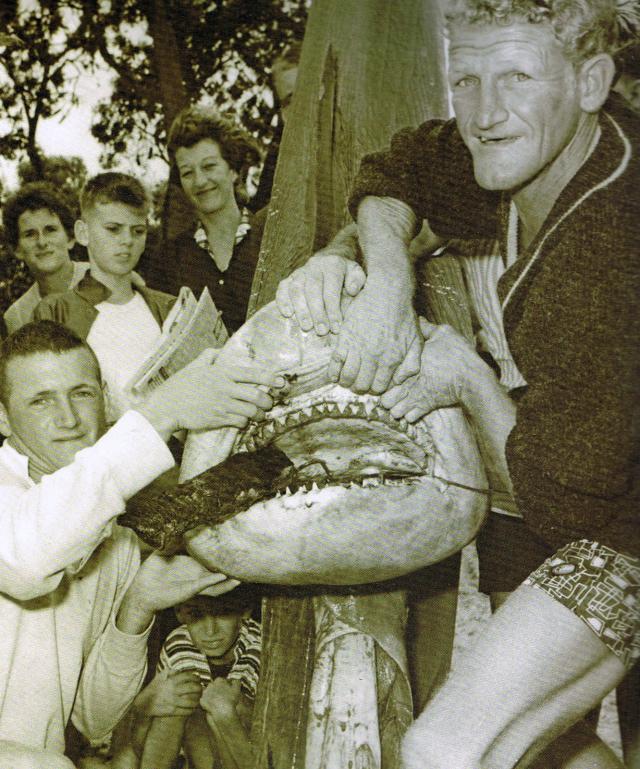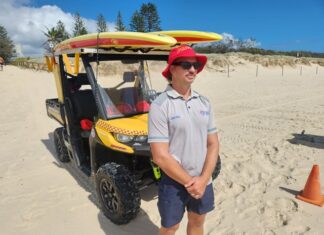On the eve of his last patrol at Noosa Main Beach after 65 years of surf life saving service, Noosa Today columnist Ron Lane was in a reflective mood as he opened up his day book to two pages of heavily highlighted memories. “Jeez, where do I start?” asked the life governor, life member and former club captain and president of Noosa Heads Surf Life Saving Club, now nearing 84.
Well, how about at the beginning?
Born in Gympie in 1938, Ron, an only child, spent his earliest years being brought up by his mum and grandparents, with his dad off at the war. But when his father returned, the little family delighted in taking the Lewis Brothers bus tour to Noosa Heads, spending the day romping on the beach and enjoying the group picnic and barbecue before heading home sunburnt and exhausted.
Ron recalls: “The thing I remember most is trying to find somewhere to hide from the sun. One day when I came back from sheltering under a shed on the dunes, Mum said she didn’t think that was such a good idea. Apparently I was lying under the floorboards of the ladies dressing room.”
An asthmatic, young Ron was warned off swimming for fear of drowning during an attack – the opposite of today’s advice – so he decided to become the next Don Bradman.
He joined the Brothers’ squad and knocked up some handy runs, but it only took one season for him to realise that he wasn’t going to average 99.
By this time he’d left Christian Brothers to take up a management traineeship at Penney’s retail stores where workmates urged him to come down to Noosa and join the surf club.
“I could hardly swim, but I thought I’d give it a go. It was hard work but I loved it from the start.”
He joined the Noosa club in 1957 and got his Bronze Medallion the following year.
“That was when the hard work started.”
After realising that he didn’t want to spend his life in a department store, he ditched Penney’s and got a job on the railways, working at Brisbane’s Northgate workshops.
“I was working with another couple of blokes who also eventually became Noosa life members. Every Friday night in summer we’d go out to Chermside and put the thumb out. We always wore our surf club shirts so they’d know we were lifesavers. Get a ride straight up. People driving further up the highway would often go out of their way and drive us down from Cooroy. Why? Because lifesavers were gods back then.”
Lifesavers were also totally committed to the invaluable work they did. Ron Lane says he’s been asked many times what inspired him to devote his life to surf life saving.
Oddly enough, it was a tragedy that occurred not in the surf but in the Noosa River.
“It was my early days at the club, Christmas time and a Monday morning when we didn’t do patrol. Some of the boys were considering going up to the Royal Mail for a counter lunch a bit later – this was before the Reef existed.
“Then the phone rang and it was the coppers. A kid was missing in the river. When we got up to Gympie Terrace there were cops there and about 30 people, including the mother of the missing 11-year-old.
“Nelson Angstrom was the only qualified lifeguard, the rest of us were still doing probation training.
“So at the water’s edge he told us where to go and we swam out and dived to the bottom. Suddenly the bloke next to me was on top of the kid. We pulled him up and got him on the beach and started doing the old Holger Nielsen face-down resuscitation method. It was my first time and a woman knelt down beside me and started chanting the Lord’s Prayer.
“I really wanted to tell her to shut up. We couldn’t revive him and at the hospital at Cooroy we were standing by the bed when they told us officially that he was gone.
“The first thing you think is, did I stuff up? The doctor said the boy was dead before we found him at the bottom of the river. I thought he was a callous bastard then but now I understand. That was when I became committed to trying to save lives.”
By 1961 Ron was Noosa’s club captain and as such had to investigate and write the official report on Noosa’s first and only fatal shark attack. While he wasn’t present during the grisly December whaler attack on surfboard rider and university student John Graydon Andrews, he spent many days interviewing those who were and going over the gruesome and complex details, including the little-known fact that the club had been supplied with faulty rubber tourniquets, forcing the attending life savers to rip out their Speedo cords and make their own.
Ron has had several of his own brushes with death over a long and distinguished lifesaving career, but the one he recalls most vividly occurred on a day of huge swell and treacherous rips at Main Beach.
“We were body surfing and it turned really bad and I was told to get our squad out of there. As we were swimming in we heard someone yell out, ‘There he is!’ And there was a big bloke behind us getting washed out in a massive rip.
“We caught up and got a hold on him and he was much bigger than we first thought and could hardly swim.
“By now we were out on the shark nets so we decided to swim him towards Little Cove. We got swept in, but then another swell came through and swept us out again.
“But I managed to drag him onto the rocks where a few of the local boardriders held us as another set rolled over us. Then we got him in. It was 3pm when we went for a body wave and after 6pm when we got back to the club. It was a long afternoon and a near thing for all of us.”
Although Ron had plenty of mates in the boardriding fraternity as surfing took off in the early ‘60s, he remained a lifelong body womper.
“I remember telling one of the older guys I was thinking about buying a board and he said, ‘Nah, there’s nothing great about riding down a wave on a hunk of wood. You gotta get out there man against the sea!’
“This bloke also told me that if you could body surf Sunshine on a big day, you could do it anywhere. This one day it was huge and dumping and I remembered a magazine article about the Hawaiian roll, where you can roll with a dumper and tuck your head in so your feet hit the sand first. But I was too slow and I rolled and landed on my head. When I got up to the surface I couldn’t move. It was a neck fracture, and if I hadn’t had mates on the beach I was gone that day.”
There’s a famous story, perhaps apocryphal, about Ron Lane that’s been doing the rounds of the local surfing community for years.
According to the late Stuart Scott’s account, one August afternoon in 1963, big blond Laney walks into the bar of the Reef Hotel, plonks a glossy magazine on the table, open at a spread of photos of perfect waves on Noosa’s points, accompanied by the headline The Mysterious North, and declares: “Now we’re stuffed!”
“That’s exactly what happened,” Ron tells me on Anzac Day Eve.
“The cat was out of the bag, secret Noosa was no more.”
Ron well knew that publicity like this would ruin it for all surfers, body or board. And he was right.
By the end of the 1960s, Noosa was on the world surfing map.
“It was never the same,” he said, “but you got used to the crowds.”
There are many highlights in Ron Lane’s storied career.
One that makes him particularly proud is his selection on the Australian delegation to the 1978 World Lifesaving Congress at Huntington Beach, California, and the profound changes to Noosa’s lifesaving capability that came out of it.
“I was requested by officials of both Sunshine Coast Branch and Queensland State Centre, to have a close look at the American tower system being used on the famous Huntington Beach, which attracted huge holiday crowds along its 13.7 kilometres.
“A couple of days after arriving I found myself in a patrol vehicle with American lifeguards, being driven along a vast stretch of beach where thousands of beach goers were all under the observation of a state-of-the-art tower system that would be perfect for Noosa. The Huntington officials made themselves available for further discussions and also presented me with a set of plans for the construction of the towers.
“I was totally convinced that this system was the way to go: study the plans, and make alterations to cover our needs. But when I arrived home I hit a brick wall. On presenting my four-page report, I stood stunned as a high-ranking executive, without reading a word, threw it into a rubbish bin, saying, ‘Listen mate, we teach the Yanks, they don’t teach us.’”
So it took a long time to happen, but like a dog with a bone, Ron wouldn’t leave it alone, chanting his mantra of “elevation, communication, three tower system” to anyone who would listen.
Now, Noosa’s three tower system, operated by the surf club, council lifeguards and the Noosa Coastguard, helps keep our beaches safe.
It is the pride of the Australian coastline, and, as he approaches his 84th birthday and leaves active duty, it is the pride of Ron Lane.

